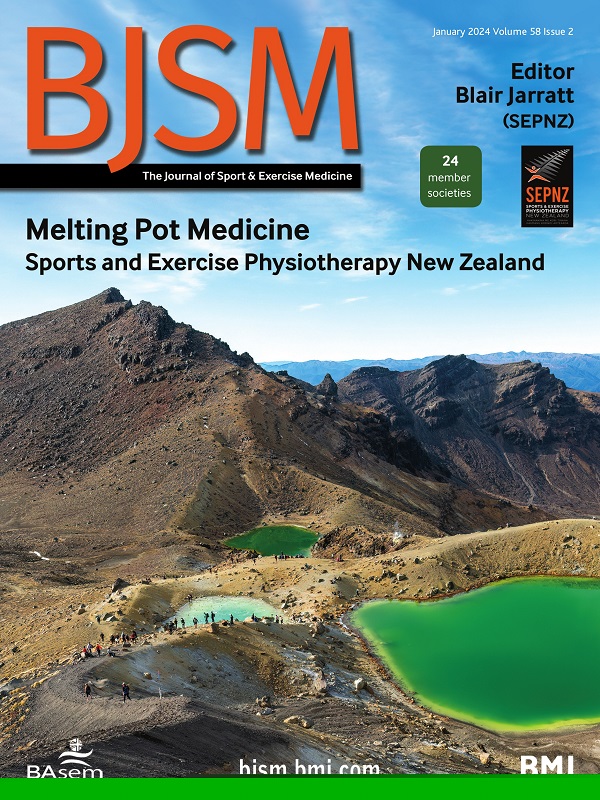Digital intervention for increasing physical activity and reducing sedentary behaviour in cancer survivors: a trial within the Cancer Prevention Study-3 cohort
IF 16.2
1区 医学
Q1 SPORT SCIENCES
引用次数: 0
Abstract
Objective The aims of this study, which uses a trial within a cohort design, were to determine the efficacy of a web-based intervention to increase moderate-to-vigorous intensity physical activity (MVPA) and decrease sedentary behaviour in cancer survivors. Methods Participants (n=415) in this trial were randomised 2:1 to an interactive physical activity website or a static balance and flexibility control website. Participants provided accelerometer data at baseline and at 3 (M3), 6 (M6) and 12 months (M12). Linear mixed models were used to investigate changes in MVPA and sedentary time overall, stratified by website use, and among participants who were inactive at baseline (<150 min MVPA/week). Results Participants were mostly women (n=391, 94%) with an average age of 63 (SD=12) years. In intent-to-treat models, there were no statistically significant between-group differences in MVPA or sedentary time at any time point. However, participants who frequently used the physical activity website (ie, once per week for ≥80% of the study period) were significantly more active at M3 (mean (95% CI); 44 (40 to 48) min/day intervention vs 35 (30 to 39) min/day control), though differences between groups were no longer meaningfully different at M6 or M12. Similarly, among participants who were inactive at baseline, the intervention resulted in an additional 50 min of MVPA per week compared with the control at M3. Conclusion While the intervention was not effective in the overall cohort, it increased MVPA in the short term among cancer survivors who frequently used the website or were inactive at baseline. Trial registration number [NCT05356988][1]. Data are available upon reasonable request. Data are available from the American Cancer Society by following the ACS Data Access Procedures (癌症幸存者增加身体活动和减少久坐行为的数字干预:癌症预防研究-3队列中的一项试验
本研究采用队列设计的试验,目的是确定基于网络的干预对增加癌症幸存者中至高强度身体活动(MVPA)和减少久坐行为的有效性。方法将415名受试者按2:1随机分组,分别进入交互式体育活动网站或静态平衡和柔韧性控制网站。参与者在基线、3个月(M3)、6个月(M6)和12个月(M12)时提供加速度计数据。线性混合模型用于调查MVPA和久坐时间的总体变化,按网站使用情况分层,并在基线时不活动的参与者()中为符合访问机密数据标准的研究人员分层。请发邮件至cohort.data@cancer.org查询访问。[1]: /查找/ external-ref ? link_type = CLINTRIALGOV&access_num = NCT05356988&atom = % 2 fbjsports % 2恐惧% 2 f2025 % 2 f06 % 2 f02 % 2 fbjsports - 2024 - 109332. -原子
本文章由计算机程序翻译,如有差异,请以英文原文为准。
求助全文
约1分钟内获得全文
求助全文
来源期刊
CiteScore
27.10
自引率
4.90%
发文量
217
审稿时长
3-8 weeks
期刊介绍:
The British Journal of Sports Medicine (BJSM) is a dynamic platform that presents groundbreaking research, thought-provoking reviews, and meaningful discussions on sport and exercise medicine. Our focus encompasses various clinically-relevant aspects such as physiotherapy, physical therapy, and rehabilitation. With an aim to foster innovation, education, and knowledge translation, we strive to bridge the gap between research and practical implementation in the field. Our multi-media approach, including web, print, video, and audio resources, along with our active presence on social media, connects a global community of healthcare professionals dedicated to treating active individuals.

 求助内容:
求助内容: 应助结果提醒方式:
应助结果提醒方式:


